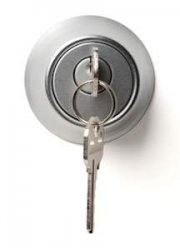 Your front door is the first line of defense against burglary. But is the current lock on your door enough? Here we discuss the types of door locks available, their proper applications and how they can enhance your home’s security.
Your front door is the first line of defense against burglary. But is the current lock on your door enough? Here we discuss the types of door locks available, their proper applications and how they can enhance your home’s security.
Privacy locks
These locks are built for interior applications and consist of a button on one side that pushes in to lock the door. On the other side is a small slot that can be used to unlock the door. Do not install or use these locks on the exterior of your home, including the door between the garage and your house.
Pros: Easy to install, convenient, very cheap
Cons: Very easy to “pick” or force open
Exterior locksets
Most Atlanta area homes have at least an exterior lockset on their doors. A standard exterior lockset consists of a doorknob with a keyhole on the outside and either a keyhole or a button that can be turned or pressed to lock the door from the inside. These doorknobs offer slightly more security than privacy locks due to more solid construction and the need to use a key to unlock.
Pros: Moderately priced, best when paired with deadbolt
Cons: Many models can be picked with just a credit card, door can be easily forced open
Deadbolts
All exterior doors in your home should have a deadbolt. A deadbolt lock is usually installed above an exterior lockset. You can also buy combination exterior lockset/deadbolt locks. Deadbolts offer more security by combining a long bolt that inserts deeper into your doorframe than standard exterior locks. Deadbolts can have a keyhole on both sides or a keyhole on the exterior and a turning knob on the inside.
Pros: Convenient, adds significant security at low investment, cost as little as $25
Cons: Higher-end models can cost over $100 and $200
Keyless Locks
Keyless or electronic locks are types of deadbolts and/or exterior locksets that can be operated without the use of a key. Popular models include keypad, remote control and fingerprint-scanning locks. These models usually include a key override, as well.
Pros: Can be extremely convenient (no keys), can integrate with your home security system
Cons: Cost – many are much more expensive than similar standard deadbolts.
Auxiliary locks
You can improve the security of your Atlanta area home with an auxiliary lock. These locks are typically installed on the inside part of your door and doorframe and used in conjunction with one or more of the listed previous locks. A popular example of an auxiliary lock is a chain door lock. One end of the chain is attached to the interior side of your door and locks by sliding the opposite end of the chain into a metal bracket mounted on the wall next to the door.
Pros: Easy to install, relatively inexpensive, works with most types of doors
Cons: Many models are easily compromised, best used as a secondary lock
A word about quality
The best lock is only as good as the door it is mounted in and the hardware used. When selecting a lock, avoid Grade 3 locks. Grade 2 is good for most homes and Grade 1 is commercial quality (and much more expensive). Make sure you have a good, exterior door and use a heavy-duty strike plate mounted with 3-inch screws.











The most frequent problem causing an outside door handle to not open the door is that the handle itself is broken.
Also, the rods attaching the handles to the latches may have come off or been knocked off, preventing the handle from operating the latch.
To determine whether the rods have come off, you'll need to remove the door trim panels and visually check to see if they're still attached.
The most frequent problem causing an outside door handle to not open the door is that the handle itself is broken.
Also, the rods attaching the handles to the latches may have come off or been knocked off, preventing the handle from operating the latch.
To determine whether the rods have come off, you'll need to remove the door trim panels and visually check to see if they're still attached.